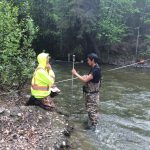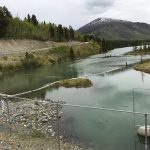There are four phases in the proposed Project’s development: pre-feasibility phase, feasibility phase, detailed design phase, and construction and commissioning phase. We are now in the detailed-design phase, when the Project is further refined with input from regulators, engineers and construction contractors.
It is during this phase that the regulatory review and permitting process also occurs.
What takes place during the review process?
During the review process, engineers, stakeholders, and the public, are involved in reviewing details about the project and project concept, and provide feedback to THEL. The process is iterative, with changes being made to the concept to respond to various concerns, as well as to build a better project. The Atlin Hydro Expansion Project (AHEP) is a significant undertaking that will have a dramatic, enduring impact on the Atlin community. It will be carefully reviewed before it goes into construction to ensure it has a positive overall impact to the Atlin community and THEL’s shareholders, and this review has already triggered a number of changes to the Project’s design.
During the earlier phases of project development (prior to the regulatory review phase) we made several changes to the project concept based on feedback from the public. These were:
- Removing a proposed surge pipe up Monarch Mountain to avoid impacts to Monarch Mountain residents;
- Moving the lower powerhouse from near the public beach area to several hundred meters away; and,
- Making the lower penstock cross Warm Bay Road in the cleared area of the campground access to avoid clearing in front of a property on South Pine Drive.
What is required for the regulatory review process?
The regulatory review process is undertaken by the Province of BC and the Taku River Tlingit First Nation (TRTFN) under their Wóoshtin yan too.aat Land and Resource Management and Shared Decision-Making Agreement (G2G Agreement). As well, for the project infrastructure located in Yukon, the Yukon Environmental and Socio-economic Assessment Board completes a review prior to permitting.
Based on the proposed activities and the size of the Project, THEL was required to develop a Clean Energy Development Plan (CEDP) to accompany all permit and license applications in BC. The requirements of this plan are outlined by BC’s Major Projects division for Clean Energy Projects in their document, “Development Plan Information Requirements” (DPIR). THEL used the DPIR to identify the baseline studies necessary to complete the Clean Energy Development Plan. THEL undertook these studies from 2014 to present and continues to collect data that will be used in future monitoring programs, if the Project is approved.
This Clean Energy Development Plan forms the basis of the regulatory review in BC. It can be viewed here.
Since the project proposal was submitted for Regulatory Review, there have been two substantive updates to the project design, as follows:
- Re-alignment of 69kV transmission line near Surprise Lake Road between one private property and the sewage lagoon access to reduce the visual impacts of clearing; and,
- Burying the 25kV powerline from the lower powerhouse to the substation at the upper powerhouse. Burying the line allows THEL to locate the line adjacent to the penstock, thus minimizing clearing along the Warm Bay Road.
Most of the above changes have significant cost implications, but are being proposed to address specific community concerns and mitigate potential impacts. The most recent updates that have occurred since the project proposal was submitted, (both of which represent less overall impact to the Atlin Community), came out of the ongoing review process and will be submitted to the Regional Clean Energy Project Team as a separate addendum.
Who reviews the Clean Energy Development Plan?
The Regional Clean Energy Project Team reviews the Plan. This team is comprised of representatives from various provincial section heads (for example, Ecosystems Branch, BC Recreation Sites and Trails, Lands, Mining, etc.), as well as the TRTFN Lands Department.
There are many provincial licenses and permits required for this Project, including for the use of Crown Land, a water license, use of the Highway right-of-way for the transmission line, and many smaller permits and authorizations, such as for cutting trees. All these licenses, permits and authorizations will be reviewed along with the Clean Energy Development Plan.
Federal authorizations are required for some activities, such as constructing works within a navigable water (Surprise Lake), and for altering and disrupting fish habitat on Pine Creek. These federal authorities will review these stand-alone applications but may work cooperatively with the Regional Clean Energy Project Team.
Where are we in the review process?
THEL officially submitted its Clean Energy Development Plan in January 2021. The Regional Clean Energy Project Team recently determined that the Plan is complete and meets the specified information requirements. In other words, the Plan has undergone the Completeness Review and is now in the second stage of review: Technical Review.
This does not mean that the Plan has been approved, only that there is enough information to begin the formal review. During this Technical Review period, the Plan will become publicly available. Once the Clean Energy Development Plan is publicly available, information regarding where and how to make comments will be provided, and public open-house events will be hosted, following COVID-19 protocols.
The Clean Energy Development Plan will be available in hard copy at the Atlin Tlingit Economic Limited Partnership (ATELP) office during the Technical Review stage. At the same time it will be available online from both the Province’s and THEL’s websites. Advertisements will be posted at the TRTFN Government Office, the Post Office and Service BC when the Plan becomes publicly available and is open for public comment.
The Technical Review stage may take six months to complete, depending on whether additional information and what kind of information is requested by the review team. Once a decision has been made as to whether to allow the Project to proceed, then permits and licenses may be issued and pre-construction work can begin.










